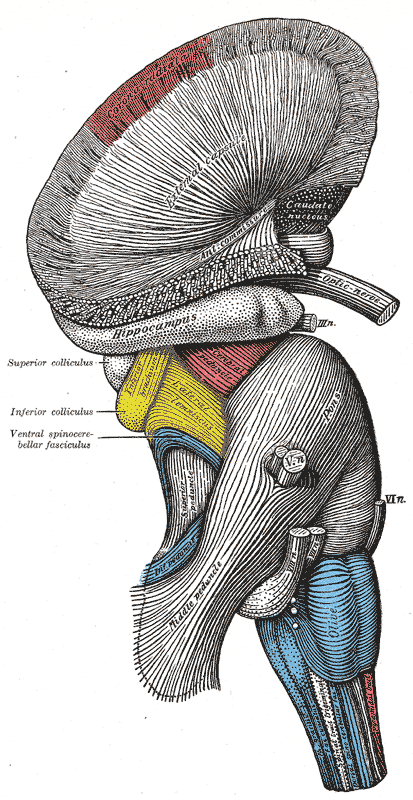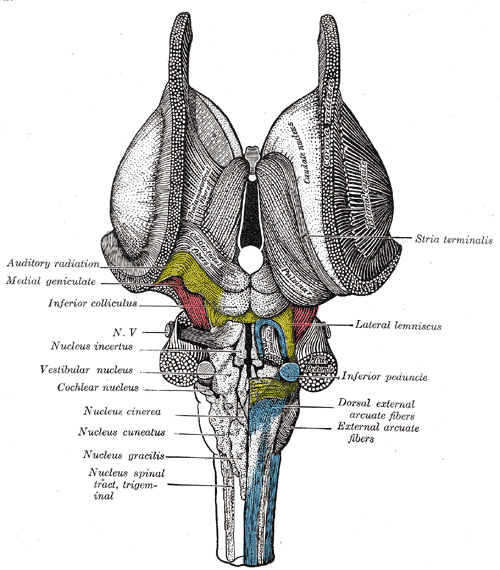[1]
Mei HX, Cheng L, Chen QC. Neural interactions in unilateral colliculus and between bilateral colliculi modulate auditory signal processing. Frontiers in neural circuits. 2013:7():68. doi: 10.3389/fncir.2013.00068. Epub 2013 Apr 19
[PubMed PMID: 23626523]
[2]
Ruchalski K, Hathout GM. A medley of midbrain maladies: a brief review of midbrain anatomy and syndromology for radiologists. Radiology research and practice. 2012:2012():258524. doi: 10.1155/2012/258524. Epub 2012 May 22
[PubMed PMID: 22693668]
[3]
Gruters KG, Groh JM. Sounds and beyond: multisensory and other non-auditory signals in the inferior colliculus. Frontiers in neural circuits. 2012:6():96. doi: 10.3389/fncir.2012.00096. Epub 2012 Dec 11
[PubMed PMID: 23248584]
[4]
Komune N, Yagmurlu K, Matsuo S, Miki K, Abe H, Rhoton AL Jr. Auditory brainstem implantation: anatomy and approaches. Neurosurgery. 2015 Jun:11 Suppl 2():306-20; discussion 320-1. doi: 10.1227/NEU.0000000000000736. Epub
[PubMed PMID: 25793729]
[5]
Bajo VM, King AJ. Cortical modulation of auditory processing in the midbrain. Frontiers in neural circuits. 2012:6():114. doi: 10.3389/fncir.2012.00114. Epub 2013 Jan 3
[PubMed PMID: 23316140]
[6]
Ito T, Oliver DL. The basic circuit of the IC: tectothalamic neurons with different patterns of synaptic organization send different messages to the thalamus. Frontiers in neural circuits. 2012:6():48. doi: 10.3389/fncir.2012.00048. Epub 2012 Jul 26
[PubMed PMID: 22855671]
[7]
Yang Y, Lee J, Kim G. Integration of locomotion and auditory signals in the mouse inferior colliculus. eLife. 2020 Jan 28:9():. doi: 10.7554/eLife.52228. Epub 2020 Jan 28
[PubMed PMID: 31987070]
[8]
Straka MM, Hughes R, Lee P, Lim HH. Descending and tonotopic projection patterns from the auditory cortex to the inferior colliculus. Neuroscience. 2015 Aug 6:300():325-37. doi: 10.1016/j.neuroscience.2015.05.032. Epub 2015 May 19
[PubMed PMID: 26002315]
[9]
Merzenich MM, Reid MD. Representation of the cochlea within the inferior colliculus of the cat. Brain research. 1974 Sep 13:77(3):397-415
[PubMed PMID: 4854119]
[10]
Chen C, Read HL, Escabí MA. A temporal integration mechanism enhances frequency selectivity of broadband inputs to inferior colliculus. PLoS biology. 2019 Jun:17(6):e2005861. doi: 10.1371/journal.pbio.2005861. Epub 2019 Jun 24
[PubMed PMID: 31233489]
[11]
Fritz TH, Renders W, Müller K, Schmude P, Leman M, Turner R, Villringer A. Anatomical differences in the human inferior colliculus relate to the perceived valence of musical consonance and dissonance. The European journal of neuroscience. 2013 Oct:38(7):3099-105. doi: 10.1111/ejn.12305. Epub 2013 Jul 16
[PubMed PMID: 23859464]
[12]
Kim SG, Lepsien J, Fritz TH, Mildner T, Mueller K. Dissonance encoding in human inferior colliculus covaries with individual differences in dislike of dissonant music. Scientific reports. 2017 Jul 18:7(1):5726. doi: 10.1038/s41598-017-06105-2. Epub 2017 Jul 18
[PubMed PMID: 28720776]
[13]
Krishnan A, Gandour JT. The role of the auditory brainstem in processing linguistically-relevant pitch patterns. Brain and language. 2009 Sep:110(3):135-48. doi: 10.1016/j.bandl.2009.03.005. Epub 2009 Apr 14
[PubMed PMID: 19366639]
[14]
Aitkin L, Martin R. Neurons in the inferior colliculus of cats sensitive to sound-source elevation. Hearing research. 1990 Dec:50(1-2):97-105
[PubMed PMID: 2076986]
[15]
Akimov AG, Egorova MA, Ehret G. Spectral summation and facilitation in on- and off-responses for optimized representation of communication calls in mouse inferior colliculus. The European journal of neuroscience. 2017 Feb:45(3):440-459. doi: 10.1111/ejn.13488. Epub 2017 Jan 4
[PubMed PMID: 27891665]
[16]
Day ML, Delgutte B. Neural population encoding and decoding of sound source location across sound level in the rabbit inferior colliculus. Journal of neurophysiology. 2016 Jan 1:115(1):193-207. doi: 10.1152/jn.00643.2015. Epub 2015 Oct 21
[PubMed PMID: 26490292]
[17]
Cabrera G, Cavelli M, Lopez C, Rodriguez-Servetti Z, Vanini G, Chase MH, Falconi A, Torterolo P. Wakefulness-promoting role of the inferior colliculus. Behavioural brain research. 2013 Nov 1:256():82-94. doi: 10.1016/j.bbr.2013.07.049. Epub 2013 Aug 7
[PubMed PMID: 23933516]
[18]
Hurley LM, Sullivan MR. From behavioral context to receptors: serotonergic modulatory pathways in the IC. Frontiers in neural circuits. 2012:6():58. doi: 10.3389/fncir.2012.00058. Epub 2012 Sep 6
[PubMed PMID: 22973195]
[19]
Darnell D, Gilbert SF. Neuroembryology. Wiley interdisciplinary reviews. Developmental biology. 2017 Jan:6(1):. doi: 10.1002/wdev.215. Epub 2016 Dec 1
[PubMed PMID: 27906497]
[20]
Basson MA, Echevarria D, Ahn CP, Sudarov A, Joyner AL, Mason IJ, Martinez S, Martin GR. Specific regions within the embryonic midbrain and cerebellum require different levels of FGF signaling during development. Development (Cambridge, England). 2008 Mar:135(5):889-98. doi: 10.1242/dev.011569. Epub 2008 Jan 23
[PubMed PMID: 18216176]
[21]
Urbánek P, Fetka I, Meisler MH, Busslinger M. Cooperation of Pax2 and Pax5 in midbrain and cerebellum development. Proceedings of the National Academy of Sciences of the United States of America. 1997 May 27:94(11):5703-8
[PubMed PMID: 9159136]
[22]
Macova I, Pysanenko K, Chumak T, Dvorakova M, Bohuslavova R, Syka J, Fritzsch B, Pavlinkova G. Neurod1 Is Essential for the Primary Tonotopic Organization and Related Auditory Information Processing in the Midbrain. The Journal of neuroscience : the official journal of the Society for Neuroscience. 2019 Feb 6:39(6):984-1004. doi: 10.1523/JNEUROSCI.2557-18.2018. Epub 2018 Dec 12
[PubMed PMID: 30541910]
[23]
Romand R, Ehret G. Development of tonotopy in the inferior colliculus. I. Electrophysiological mapping in house mice. Brain research. Developmental brain research. 1990 Jul 1:54(2):221-34
[PubMed PMID: 2397588]
[24]
Tatu L, Moulin T, Bogousslavsky J, Duvernoy H. Arterial territories of human brain: brainstem and cerebellum. Neurology. 1996 Nov:47(5):1125-35
[PubMed PMID: 8909417]
[25]
Louveau A, Smirnov I, Keyes TJ, Eccles JD, Rouhani SJ, Peske JD, Derecki NC, Castle D, Mandell JW, Lee KS, Harris TH, Kipnis J. Structural and functional features of central nervous system lymphatic vessels. Nature. 2015 Jul 16:523(7560):337-41. doi: 10.1038/nature14432. Epub 2015 Jun 1
[PubMed PMID: 26030524]
[26]
van Lessen M, Shibata-Germanos S, van Impel A, Hawkins TA, Rihel J, Schulte-Merker S. Intracellular uptake of macromolecules by brain lymphatic endothelial cells during zebrafish embryonic development. eLife. 2017 May 12:6():. pii: e25932. doi: 10.7554/eLife.25932. Epub 2017 May 12
[PubMed PMID: 28498105]
[27]
Moore JK, Perazzo LM, Braun A. Time course of axonal myelination in the human brainstem auditory pathway. Hearing research. 1995 Jul:87(1-2):21-31
[PubMed PMID: 8567438]
[30]
Niu Y, Kumaraguru A, Wang R, Sun W. Hyperexcitability of inferior colliculus neurons caused by acute noise exposure. Journal of neuroscience research. 2013 Feb:91(2):292-9. doi: 10.1002/jnr.23152. Epub 2012 Nov 14
[PubMed PMID: 23151900]
[31]
Kershenovich A, Silman Z, de Rungs D, Koral K, Gargan L, Weprin B. Tectal Lesions in Children: A Long-Term Follow-Up Volumetric Tumor Growth Analysis in Surgical and Nonsurgical Cases. Pediatric neurosurgery. 2016:51(2):69-78. doi: 10.1159/000442795. Epub 2016 Jan 21
[PubMed PMID: 26789512]
Level 3 (low-level) evidence
[32]
Lapras C, Bognar L, Turjman F, Villanyi E, Mottolese C, Fischer C, Jouvet A, Guyotat J. Tectal plate gliomas. Part I: Microsurgery of the tectal plate gliomas. Acta neurochirurgica. 1994:126(2-4):76-83
[PubMed PMID: 8042559]
[34]
Kwee IL, Matsuzawa H, Nakada K, Fujii Y, Nakada T. Inferior colliculus syndrome: Clinical magnetic resonance microscopy anatomic analysis on a 7 T system. SAGE open medical case reports. 2017:5():2050313X17745209. doi: 10.1177/2050313X17745209. Epub 2017 Dec 5
[PubMed PMID: 29238582]
Level 3 (low-level) evidence
[35]
Litovsky RY, Fligor BJ, Tramo MJ. Functional role of the human inferior colliculus in binaural hearing. Hearing research. 2002 Mar:165(1-2):177-88
[PubMed PMID: 12031527]
[36]
Stimmer H, Borrmann A, Löer C, Arnold W, Rummeny EJ. Monaural tinnitus from a contralateral inferior colliculus hemorrhage. Audiology & neuro-otology. 2009:14(1):35-8. doi: 10.1159/000152854. Epub 2008 Sep 4
[PubMed PMID: 18769025]
[37]
Poliva O, Bestelmeyer PE, Hall M, Bultitude JH, Koller K, Rafal RD. Functional Mapping of the Human Auditory Cortex: fMRI Investigation of a Patient with Auditory Agnosia from Trauma to the Inferior Colliculus. Cognitive and behavioral neurology : official journal of the Society for Behavioral and Cognitive Neurology. 2015 Sep:28(3):160-80. doi: 10.1097/WNN.0000000000000072. Epub
[PubMed PMID: 26413744]
[38]
Smit JV, Janssen ML, van Zwieten G, Jahanshahi A, Temel Y, Stokroos RJ. Deep brain stimulation of the inferior colliculus in the rodent suppresses tinnitus. Brain research. 2016 Nov 1:1650():118-124. doi: 10.1016/j.brainres.2016.08.046. Epub 2016 Aug 31
[PubMed PMID: 27592136]
[39]
Berger JI, Coomber B. Tinnitus-related changes in the inferior colliculus. Frontiers in neurology. 2015:6():61. doi: 10.3389/fneur.2015.00061. Epub 2015 Mar 30
[PubMed PMID: 25870582]
[40]
Ribak CE. An abnormal GABAergic system in the inferior colliculus provides a basis for audiogenic seizures in genetically epilepsy-prone rats. Epilepsy & behavior : E&B. 2017 Jun:71(Pt B):160-164. doi: 10.1016/j.yebeh.2015.02.024. Epub 2015 Mar 23
[PubMed PMID: 25812940]
[41]
Faingold CL, Naritoku DK, Copley CA, Randall ME, Riaz A, Anderson CA, Arnerić SP. Glutamate in the inferior colliculus plays a critical role in audiogenic seizure initiation. Epilepsy research. 1992 Nov:13(2):95-105
[PubMed PMID: 1361165]
[42]
Parham K, Willott JF. Effects of inferior colliculus lesions on the acoustic startle response. Behavioral neuroscience. 1990 Dec:104(6):831-40
[PubMed PMID: 2285482]
[43]
Plourde G. Auditory evoked potentials. Best practice & research. Clinical anaesthesiology. 2006 Mar:20(1):129-39
[PubMed PMID: 16634420]
[44]
Martin WH, Stecker MM. ASNM position statement: intraoperative monitoring of auditory evoked potentials. Journal of clinical monitoring and computing. 2008 Feb:22(1):75-85
[PubMed PMID: 18058246]
[45]
Caird DM, Klinke R. The effect of inferior colliculus lesions on auditory evoked potentials. Electroencephalography and clinical neurophysiology. 1987 May:68(3):237-40
[PubMed PMID: 2436886]


